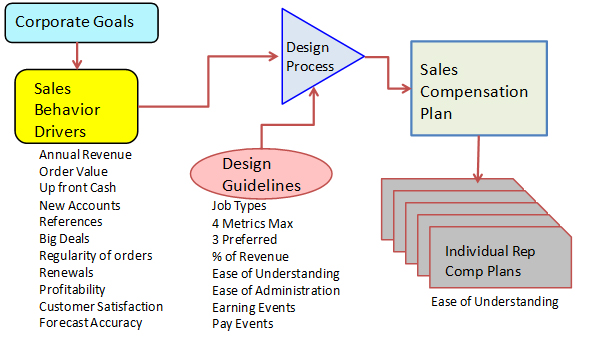- President’s Club
- Variable Compensation
- Monthly Rankings
- Special Awards
- Coaching & Training
- Opportunities for career growth
Focusing on Sales Compensation, the most important element, that is sometimes ignored by sales comp plan designers, is the alignment of the plan with Corporate Goals. While the members of the executive team are usually in synch on the goals, they often have important differences on the priorities for sales behavior. Or, the number of sales behavior goals grows to the point that they do not motivate sales reps at all. The Sales department is usually the most expensive and variable sales compensation is often 40% or more of that expense. This emphasizes the importance of getting the design right.
When the Sales Compensation Plan is not aligned with Corporate Goals, the results are high cost of selling, entering markets through Sales Accidents, high customer support costs, unhappy customers and high churn rates. It is odd then, that many companies do a poor job in this area. In addition, the plan needs to be transparent and easily understandable by the sales reps. The plan should also enable the company to attract high performers. A key attribute of successful Sales Compensation Plans is that 60% to 70% of the reps achieve or exceed quota. When the percentage of reps achieving quota falls below sixty percent, the result is high turnover. In Enterprise Solution selling, the time to get a new rep up to speed runs4 to 9 months. The opportunity cost of replacing a rep that is producing and leaves is on the order of one half their annual quota. When sales turnover is high, the total cost of selling zooms through the roof. Yet, CFOs and CEOs want to raise quotas to the point where turnover becomes an issue.This highlights the need to have Sales Compensation integrated with Quota Plans and Territory Management.
Some questions to ask about your Sales Compensation Plan:
- Does It Implement Corporate Goals?
- Does It Drive Desired Behavior?
- Does It Change with Corporate Goals?
- Does It Enable You To Attract & Retain Stars?
- Is It Easily Understood?
- What % of Reps Achieve Quota?
- Can you administer it easily &transparently (people, data, dispute process)
This shows an Integrated Sales Management Process model that I developed years ago. It integrates the key elements of Sales Compensation, Sales Behavior, Measuring Customer Commitment, Forecast Accuracy and Continuous Improvement in an easy to understand way. I have utilized this to improve performance in my roles as a company officer as well as in numerous consulting projects with clients.
Sales Compensation Metricscan be various depending in the industry, company maturity and focus issues. Here is a list of many of the metrics we see being implemented:
- Annual Revenue
- Annual Recurring Revenue (ARR)
- Total Contract Value (TCV)
- Renewals
- Upfront Cash
- New Account Acquisition
- References
- Big Deals
- Regularity of orders
- Profitability / Gross Margin
- Customer Satisfaction
- Forecast Accuracy
- Expense control
- MBOs
- Contests and SPIFS as appropriate
As we said above, the challenge is to select no more than two, or three to drive sales behavior.
It also important to recognize that when you choose a particular metric, there may be unintended consequences. For example, if you pay more for high margin orders than for low margin orders, you might see overall order rates (and total revenue) decline.
The diagram below shows a simplified view of the Sales Compensation Design Process.
Corporate Goalsset the Sales Behavior Drivers. Design Guidelines define the job types eligible for variable pay, the number of metrics, % of revenue to be spent on variable compensation, the Earning Events, the Pay Events, and administration rules including exceptions and dispute resolution.
It is important to have transparency such that the reps feel they are getting paid what they deserve, according to their individual plans. This implies that accurate and timely reporting be implemented.
A key feature of modern sales compensation systems, such as Xactly, is the ability of a sales rep to access current commissions earned and pro forma commissions for closing a new deal on mobile devices in real time.
It is also key that the Pay Events be as close in time as possible to the Earning Events (such as Order Booking) to maximize the motivational impact of variable pay.
For additional insight into your sales compensation plan, contact Chuck DeVita, President of Growth Process Group at 408-252-5518 or cdevita@growthprocess.com.
Growth Process Group provides seasoned sales, marketing and management resources combined with proven programs developed specifically for enterprise technology, software and SaaS solutions and energy technology solution providers.We work as consultants or as interim executives to accelerate revenue growth, acquire customers and improve sales productivity. We also facilitate and guide clients through reorganizations, strategic positioning, business planning, and developing value propositions and pricing models. Growth Process Group has been serving technology companies that have complex business to business sales and customer service relationships since 1995.
For info on Growth Process Group, go to www.growthprocess.com


